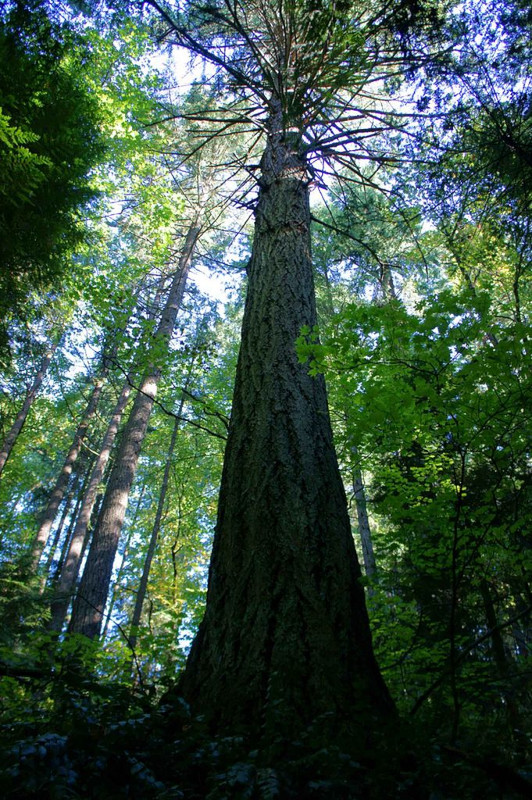There is no moment too small in the world. Nothing should be lost. Everything has a purpose, and everything is in need of care. This is my creed —Suzanne Simard
Preamble We now know the answer to the question about what happens when you cut enough living trees above ground and dig up enough dead trees below ground. What happens is the Climate Crisis and, with it, a time of the great forest dying, a time when the forests themselves get into the act and, whether by drought, insect, fungus or wind, lay themselves down ahead of the coming conflagration.
On Island Earth, the dying began about a decade ago and is now well underway. In the high-elevation oldgrowth forests not far from here, the situation is already dire, with four of every ten old trees now standing dead, and the ground now strewn with fallen snags.
Projecting ahead (and putting wildfire aside; see below), a time will soon come when today’s old forests will, in many regions, be gone. And though young trees are of course sprouting up in place of the old, many/most will never reach maturity, so rapidly is the weather of the world changing.
Terrible as it is to write these things, my message nonetheless contains its own small rainbow: the time has come for us to love the forests of the world as never before. The time has come to spend time in them, to sing their praises, to integrate them into our art and culture, to fight for them as necessary, to safeguard them as we can. Please read on.
First Approximation
The Climate Crisis, of course, speaks in different vernaculars in different parts of the world. In the American southeast it speaks above all in the uproarious tongue of hurricane. In the American southwest it speaks mostly in the parched creole of drought. Here in forested northwestern North America, it speaks above all in the chinook jargon of wildfire. Nor is there anything anybody can do about it, short of the seeming impossible goal of drastically lowering global greenhouse gas emissions of course. Best therefore to get with the programme and prepare for the worst.
And yet, and yet: while all forests everywhere are surely fated to burn sooner or later – this too is the meaning of climate change – surely not all forests everywhere will burn all at once or, indeed, in the space of any single human lifetime. Those of us who love forests therefore need not despair utterly; there’s still room for action at time scales meaningful to ourselves, namely to gird, as best we can, our beloved woodlands today against the appetite of wildfire tomorrow.
This is where Saving the Sister Trees comes in. As I use the term, Sister Trees are simply Suzanne Simard’s Mother Trees in waiting; they’re robust, healthy, fire-resistant trees of medium to advanced age; they’re trees that may sooner or later become keystone to the healthy establishment and maintenance of the next forest generation.
For the fact remains that wildfire, even at its most daunting, is ever a fickle beast. Always on the rampage, burning as it goes, consuming as it passes, the fact remains that nobody, not even wildfire itself, knows from moment to moment which patch of trees it will reduce to ashes and charcoal, and which pass over.
This being the case, who can say but that judicious tending of a beloved forest stand near you – limbing here, removal of woody material there – won’t decide the Fire Dragon on its next rampage to steer around rather than through? This is what forest stewardship in the Pandoracene must look like – no longer cut, cut, cut (which the outsized role played by forests in carbon sequestration now forbids), but tend, tend, tend. Thus an ethic of reciprocity rather than of take and take and take. A kind of Elvin Work if you will.
To sum up, Saving the Sister Trees is about helping ensure that Mother Trees can continue to come on line even in the wake of wildfire. It’s a gesture of caring aimed at forest ecosystems now much stressed by changing climate. At a personal level, it’s also about finding a way of having agency toward the future in a time when many of us feel weighed down by a sense of hopeless incapacity.
Should you and your group decide to take part in this project, I’ll tour you around Island Earth, instruct you on some of the finer points of Sister Tree recognition, introduce you to some good candidate trees, and ask you to select one or more of them for “adoption”. These things done, we’ll then role up our shirt sleeves and get at it: delimbing, brushing, and clearing away combustibles in the vicinity of the adopted tree or trees, with a view to increasing their chances of withstanding the next round of wildfire intact.
May the forest be with you always —Trevor
Next up: Best of Friends
